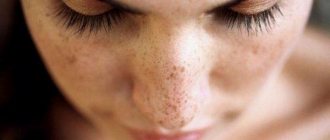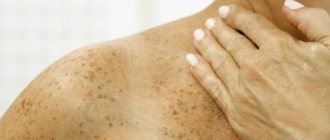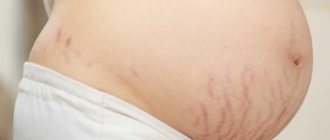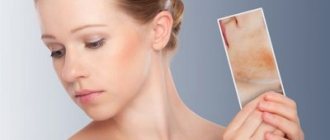Red spots during pregnancy
But yellow-brown pigment spots are not the only ones that can make you confused and anxious. Often, expectant mothers become covered with red spots, which can also burn or itch. In this case, most likely you are faced with an allergy. Even if you have never reacted this way to any irritating factors before, now it is more than possible. It is during pregnancy that a woman encounters many troubles for the first time, since the reaction of the body as a whole is very unpredictable due to the continuous processes and changes taking place in it. And just one orange or a cube of chocolate can cause red spots to appear on the skin, even if in your pre-pregnancy life you only ate citrus fruits and cocoa.
In general, some caution must be exercised when dealing with frankly allergenic foods during this period, since even a baby can react with childhood diathesis to your cravings. But if it so happens that an allergy is present, the first step is to eliminate the source of the irritant. This could be a food or household allergen, so analyze everything: a new pillow, changed powder or cream, something you ate. Even vitamin complexes for pregnant women often cause allergic reactions in mothers. Find the cause and eliminate it, and then go to an allergist or dermatologist. The doctor will examine and interview the woman and prescribe her further treatment and give further recommendations for implementation. In the meantime, you can make lotions from infusions of chamomile or string.
From now on, be more attentive to yourself. And don’t let any stains darken your pregnant routine. Enjoy this time, it will soon fly by forever...
Age spots during pregnancy are usually yellow-brown or dark brown. The reason for their appearance in women is hormonal changes. The scientific name for age spots is chloasma or melasma. They disappear on their own after normalization of hormonal levels and stabilization of the monthly cycle.
During pregnancy
During pregnancy, the levels of estrogen and progesterone change.
These hormones have many functions, one of them is regulating the amount of melanin in the skin. When the amount of these active substances becomes unstable, the pigment in the epidermis accumulates unevenly, resulting in areas of color of varying intensity. Pigment spots during pregnancy usually appear in the second trimester.
They must be distinguished from melanoma, a dangerous cancer. Characteristic signs of chloasma are:
- color from yellow-brown to dark brown;
- clear boundaries;
- the pigment spot is often irregular in shape;
- it goes flush with the skin, does not rise;
- there is no itching or irritation.
The following predisposing factors increase the likelihood of melasma:
- dysfunction of the pituitary gland, liver, thyroid gland, ovaries;
- use of contraceptives;
- lack of vitamin C, folic acid;
- lack of iron, zinc, copper;
- use of antibiotics;
- the use of benzonal, depakine and other drugs for epilepsy;
- diabetes;
- genetic predisposition;
- stress;
- use of bad cosmetics;
- cosmetic procedures, solarium.
Prevention of pigmentation during pregnancy
- spend as little exposure to open sunlight as possible;
- use children's sunscreen and umbrellas;
- avoid applying low-quality cosmetics (and those containing vitamin A) to the skin, especially in warm and hot seasons;
- do not contact with chemicals;
- try to eat healthy foods containing folic acid, vitamins C and E: green leafy vegetables, cabbage, high-quality vegetable oil, cereals, fish, liver and beets;
- regularly examine the thyroid gland with a therapist;
- try to protect the body as much as possible from diseases of the genitourinary system.
Women predisposed to age spots while expecting a child need to take preventive measures to prevent their appearance
Choice of cream
You can buy whitening cream for pregnant women at the pharmacy:
- Zinc ointment dries the skin, binds and removes toxins. Has an anti-inflammatory effect.
- Synthomycin liniment. Whitens age spots, relieves inflammation, gets rid of germs. The active ingredient is chlorampheniol.
- Salicylic acid. Can be used to eliminate the top layer of skin along with pigment spots. Creates an anti-inflammatory effect.
- Retinoic ointment. The active ingredient is isotretinoin. Removes inflammation, destroys microbes, regulates the functioning of melanocytes.
- Sulfur ointment kills germs and parasites, exfoliates the upper layers of the skin along with pigmented areas.
- Melanative. The whitening agent is alpha-arbutin, it also contains vitamin E, kojic and glycolic acid. The cream reduces the activity of melanocytes.
- Skinoren ointment. The active ingredient is azalic acid. Has anti-inflammatory, antibacterial effect.
Treatment on the face
Pigment spots during pregnancy can form on any part of the body, but more often women find them on the face, as the most noticeable place. They can be localized on the forehead, chin, cheeks, bridge of the nose and around the eyes. Often the cause is the use of low-quality cosmetics and unprofessional cosmetic procedures. Pigment spots appear especially often after prolonged sunbathing.
Chloasma is not dangerous and disappears on its own over time.
Doctors do not recommend doing anything about the spots; it is better to prefer a wait-and-see approach. After childbirth, they lighten and disappear completely. During pregnancy, you can try to eliminate the resulting pigment spots, but they will appear again. In addition, many skin lightening products and methods can cause even more harm.
Some drugs contain hydroquinone, which has a negative effect on the child.
Folk remedies can act more gently, but their effectiveness often tends to zero. You can try masks made from the pulp of berries, vegetables and fruits. Also, many girls use green tea tonics and lotions.
The following methods show the greatest effectiveness:
- taking vitamin C and folic acid;
- restriction of UVF, use of a wide-brimmed hat on the street;
- fitness, gymnastics, running or swimming;
- proper nutrition, eat more vegetables, grains, fish, dairy products;
- proper rest, proper sleep.
How to get rid of spots after childbirth
Usually, pigmentation on the abdomen and chest disappears on its own after the birth of the child. Two to three months are enough for this. Sometimes this period increases to a year. If spots remain after this, you need to go to a specialist and rule out pathologies that could be the root cause of hyperpigmentation. If they are absent, the problem will be solved in a beauty salon. It is enough to choose the appropriate procedure and be sure to discuss it with the pediatrician if the baby is breastfed. The technique must be safe for the child and mother. The most effective and harmless ways to combat pigmentation are considered to be medicinal creams and laser. It is also possible to use folk remedies.
Pigment spots occur against the background of changes occurring in the body of a pregnant woman. This phenomenon can be successfully combated, but you must first obtain a doctor’s approval. He will help you choose the best product and restore beauty.
Treatment on the body
Pigment spots during pregnancy can appear on the chest, abdomen, thighs and shoulders; they also appear on the back, but they are rarely found there. Hormonal changes are often the cause. Predisposing factors are diabetes mellitus, pathologies of the thyroid gland, liver, ovaries, and pituitary gland. Poor nutrition, stress, and taking certain medications can also push the body toward hyperpigmentation.
To reduce the formation of age spots and speed up the resorption of existing ones, you can use the following methods:
- spend less time under UV rays, use sun ointments, wear a hat;
- doing fitness, going to the pool, gymnastics will speed up the metabolism, which will reduce hormonal changes;
- You can only use high-quality cosmetics;
- eat right, drink more water, eat vegetables, cereals, fish and dairy products;
- take vitamin C and folic acid;
- try to rest and sleep well;
- Take any medications with caution.
Doctors do not recommend using any bleaching agents. Firstly, low-quality ointment can worsen the situation, and the active ingredients often have a negative effect on the child. Secondly, the products are often ineffective and do not stop the formation of new spots; after pregnancy, they resolve on their own.
Causes of age spots
The main reason for darkening of the skin during pregnancy is hormonal changes that are necessary for the successful bearing of a child.
An increase in hormone levels activates the production of melanin, which causes the color of the skin to change. Hyperpigmentation is most pronounced in the second and third trimester. In addition, the cause of the appearance of spots on the stomach during pregnancy can be:
- long-term use of oral contraceptives before conception;
- lack of folic acid;
- liver function disorders, ovarian pathologies;
- use of low quality perfumes and decorative cosmetics;
- prolonged exposure to the sun;
- hereditary factor.
After childbirth
After childbirth, age spots do not disappear immediately, so there is no need to worry when you have already given birth, but hyperpigmentation does not subside. Normally, the situation remains the same for another 1-2 weeks, a decrease in the intensity of the formation of spots can be detected after a few weeks, and everything goes away completely only after 2-3 months.
To speed up the process, you can use several methods:
- Tonics. They restore elasticity to the skin, improve metabolism, which promotes faster resorption of pigment. For these purposes, you can use both specialized tonics (without alcohol) and natural products: cucumber, citrus fruits, currants, raspberries.
- You can apply ice to the resulting stains. Constriction of blood vessels will reduce pigmentation of the area. For freezing, it is recommended to use citrus juices (lemons, oranges) rather than water. You need to apply small pieces to the stains, wait until they completely melt, and then wipe off the remains with a towel.
- Whitening masks and compresses. To restore skin metabolism, you can use special fortified formulations. It is recommended to use honey (vitamins and microelements), lemon juice (vitamin C) and curdled milk (amino acids). All ingredients are taken in equal proportions. Keep the mask on for 15 minutes.
- Many people recommend using a special whitening cream or ointment. These funds can be divided into 2 groups. The first ones normalize metabolism - these are safe and useful drugs. For the second, the action is based on the destruction of melanocytes - these are stronger, but also more dangerous drugs.
During lactation
Pigment spots disappear a few months after childbirth. However, lactation begins much earlier, so you should not be surprised if they form when you are already breastfeeding your baby. In some cases, pigment spots disappear only a year after birth, it is at this time that the pathology can be diagnosed and treatment measures can begin.
For therapy, you can contact an endocrinologist, dermatologist or gynecologist. To investigate the cause of the pathology, blood is taken to analyze hormone levels, and a biopsy of the pigment spot can also be taken. For treatment, hormonal drugs are used, their task is to normalize metabolism. Read this article about how to disguise age spots.
Pregnancy is a period of enormous restructuring of the body, associated not only with the pleasant anticipation of the baby’s arrival, but also with significant discomfort. In addition to an enlarged belly, expectant mothers face a lot of changes, one of which is age spots (melasma, chloasma) on the face and body. Appearing during pregnancy, they are distinguished by a wide area of localization and a pronounced shade.
Causes of age spots during pregnancy
During the formation of the fetus, the female body is completely rebuilt: the production of hormones responsible for the amount of melanin in the tissues of the epidermis increases significantly. Increasing levels of progesterone and estrogen lead to changes in the structure of every cell in the body. As a result, excess melanin, which determines skin color, begins to accumulate in the most vulnerable areas.
In addition to the appearance of small dark patches or contour freckles on the face, during pregnancy you may notice age spots on the back, neck, chest and arms. During this period, women's nipple halos also darken, and after the first trimester a clear line appears connecting the pubis and the navel. And the darker the initial skin tone of the expectant mother, the more pronounced the pigmentation appears on her face and body.
In addition to hormonal changes, the following factors can cause the appearance of age spots during pregnancy:
- lack of vitamins in the body;
- hereditary predisposition;
- use of oral contraceptives before pregnancy;
- excessive exposure to ultraviolet rays;
- use of low-quality decorative and hygienic cosmetics.
Due to sudden hormonal changes, pigment spots on the face and body may appear already in the first weeks of pregnancy, but usually the problem becomes more noticeable after the second trimester or immediately before childbirth. It is characterized in the same way in both light-skinned and dark-skinned women: dark spots of different sizes and shapes appear on the skin.
Causes of a cosmetic defect
In truth, hormone deficiency is not the only cause of the defect. There are other factors that can cause pigment spots to appear during pregnancy.
The first and most important point in this whole “spotty” story is the concentration of melanin in the skin of every person, inherent in nature. This coloring pigment accumulates in specific molecules, which science has dubbed melanosomes. Their main task is to protect the upper skin from contact with aggressive ultraviolet radiation. The higher the melanin content in the skin, the darker it is, and the higher the risk of pigment spots appearing on it.
The completed conception becomes a trigger for hormonal changes, which makes adjustments to the process of synthesis and accumulation of dye in the skin. This is taken care of by the adrenal glands, which begin to diligently produce estrogens, progesterone and melanocyte-stimulating hormone. As a result, the level of melanin in the skin increases significantly. Excessive amounts of pigment are concentrated in the most unexpected places for the expectant mother on the face and body.
An increased concentration of the dye causes the development of hyperpigmentation. This is exactly what a pregnant woman encounters when she watches with horror the rapidly darkening skin on certain areas of the back, neck, chest and face. As we have already noted, hyperpigmentation becomes especially widespread at the beginning of the second trimester and slows down slightly in the later stages of pregnancy.
Note that a sharp increase in the level of melanin in the skin can be dictated not only by the natural laws of physiology, but also by other reasons:
- the appearance of dark spots on the skin is sometimes a consequence of long-term use of oral and antiepileptic drugs before pregnancy;
- in some cases, hyperpigmentation will indicate to the specialist a lack of folic acid in the body of the expectant mother;
- increased pigmentation makes itself felt in liver function disorders, pituitary diseases, ovarian pathologies, excessive use of perfumes and decorative cosmetics of dubious quality;
- A “spotty” skin color in a pregnant woman is highly likely to appear after prolonged contact with ultraviolet radiation. It’s not for nothing that freckled people (and freckles are the most common age spots) are called sun-kissed;
- Most often, hyperpigmentation is a hereditary factor.
What should you be wary of?
Places where melanin accumulates are characterized by an exclusively yellow-brown color. With pigmentation, the skin becomes covered with asymmetrical, chaotically located spots that do not cause any discomfort. If they acquire a pink, red or burgundy hue and are accompanied by itching or burning, the expectant mother should urgently adjust her diet and consult an allergist.
This reaction of the body can be triggered by the wrong combination of ingredients consumed in food, or the abuse of certain foods. Moreover, an allergic rash on the face and body can appear in absolutely every woman, including those who were not prone to such manifestations before pregnancy.
How to get rid of age spots during pregnancy
Brown spots on the face and body, caused by the accumulation of melanin pigment, do not pose any danger to the expectant mother, except for negative emotions due to aesthetic imperfection. They arise as a result of natural processes in her body and completely disappear after breastfeeding. However, this does not mean that pregnant women cannot temporarily reduce unwanted symptoms.
You can lighten pigment spots using:
- Lightening mask made from kefir and cottage cheese. To do this, you need to mix the ingredients in equal proportions, apply to the entire face and problem areas on the body for 20 minutes.
- Lemon. Freshly squeezed concentrate should be applied pointwise, only to darkened areas of the skin. If a burning sensation occurs, wash with cool water.
- Cucumber juice compress. To do this, you need to grate the cucumber, squeeze out the liquid, moisten gauze with it and apply to problem areas for 20 minutes.
- Parsley. The greens need to be poured with boiling water and left for 1 hour. Then pour the cooled broth into molds and freeze. Use the resulting pieces of ice to wipe away age spots on the skin.
- Tropical mask. When preparing, you can use any citrus fruit. They need to be pureed and the resulting pulp applied to problem areas.
During pregnancy, you can also use store-bought whitening products. However, do not forget about safety: the composition of the tonic or cream for age spots should not be too aggressive. It is better if it is based on a high concentration of ascorbic acid.
ethnoscience
If, due to the lightening of certain areas of the skin - especially on the face - a woman becomes very nervous and feels discomfort, then you can use one of the folk remedies:
- mix 2 tbsp. l. liquid honey with juice of 1 lemon. Scoop up a little of the resulting mass with a cotton pad and apply to pigmented areas for 20 minutes. After this, rinse with water at room temperature;
- wipe white stains with homemade yogurt;
- take 1 tbsp. l. milk and sour cream, combine in a small bowl and mix thoroughly. Dip a cotton pad into the mixture and generously apply it to problem areas. Rinse off the product after 30 minutes;
- if the cause is allergies, then it is advised to drink decoctions of celandine, string, nettle, chamomile and calendula.
Before resorting to any of the listed remedies, you should make sure that the expectant mother does not have an allergic reaction to one of the ingredients. Even if there was no intolerance before, it can occur during pregnancy. But all these measures will not actually get rid of the source of the problem.
It is best to mask the spots with cosmetics during this period, and start treatment after childbirth, if the spots still remain. Then this problem may be solved by cleansing the skin with acid or laser peeling. This will require from 3 to 10 procedures.
It is necessary to get rid of white spots during pregnancy only when the cause of their appearance is an exacerbation of chronic ailments. But even in this case, you should fight the disease, and not one of its symptoms.
Prevention of skin defect
No woman has yet managed to avoid hormonal changes while expecting a baby, but everyone can prevent negative consequences and preserve natural beauty.
You can avoid the appearance of brown spots on the skin by eliminating provoking factors:
- During pregnancy, it is better to limit the consumption of coffee, black tea and unnatural, too spicy or fatty foods, which complicate the work of the liver and provoke the production of melanin. While expecting a baby, you should give preference to plant and dairy products.
- It is necessary to increase the intake of vitamins into the body; for this it is better to give preference to natural fruits and vegetables. In the autumn-winter period, you can use special fortified complexes for pregnant women.
- Exposure to the sun should be limited. Aggressive UV radiation does not have the best effect on the condition of already sensitive skin.
If exposure to the open sun is unavoidable, you can use special protective creams. To avoid the appearance of age spots, pregnant women are advised to avoid using cosmetics based on chemical components, so they should choose natural-based products.
Pigmentation caused by changes in the body is an absolutely natural and safe process that begins during pregnancy and continues until the moment of childbirth, or, in extreme cases, until breastfeeding stops. When the level of estrogen and progesterone in the blood stabilizes, age spots smooth out without leaving a trace.
If pigmentation does not disappear 2-3 years after childbirth, you can contact a cosmetologist. A competent specialist will quickly and painlessly help you get rid of unwanted spots on your face and body in just a few sessions.
Prevention of age spots during pregnancy
It is useless to fight hormones, but in many cases the woman herself is “to blame” for increased pigmentation. And it’s not just a matter of long exposure to the sun, but also some nutritional disorders. There are simple preventive measures that will help avoid hyperpigmentation.
Prevention of the problem:
- Your daily diet should include vegetables, herbs, fruits, berries,
- Green leafy vegetables are preferred,
- Meat, fish, poultry and cereals should also not be rare items on the menu,
- Include vegetable oil in your diet, but do not fry with it, but season vegetable salads with it,
- Reduce your consumption of black tea and coffee,
- Drink plenty of clean water (maybe with lemon and honey),
- Do not use unknown cosmetics - only those products that you are confident in their effects.
- Avoid stress
- Visit an endocrinologist in a timely manner; sometimes pigmentation occurs due to disorders of the thyroid gland.
And, of course, a tan! Everyone knows that it is of little use. Healthy sunbathing and hypersolarization are completely different things. Therefore, the expectant mother has nothing to do in the intense sun. If pigmentation does not go away after childbirth, go to a dermatologist or cosmetologist. There are a lot of simple, harmless procedures that can cope with this problem.
For example, special medicinal creams and laser work wonders. But this is the work of a specialist who knows all the techniques and will not harm the woman’s skin. Do not rush to see a doctor immediately after giving birth; the spots will not go away in one day, but after a couple of months they usually disappear.
Pigment spots during pregnancy: causes of appearance
Although the appearance of age spots during pregnancy is a natural phenomenon, you can reduce the risk of their occurrence by understanding the causes of their occurrence and reducing triggers. Most often, pigment spots appear during pregnancy due to an increase in the production of estrogen, progesterone, and melanocyte-stimulating hormone. Due to hormonal changes, skin cells begin to secrete increased amounts of melanin, which concentrates in certain areas of the face. This process leads to hyperpigmentation.
Most often, dark pigment spots appear on the neck, décolleté, around the nipples on the mammary glands, on the face (upper lip, chin, cheeks, forehead), and on the back.
In addition, the appearance of age spots is caused by vitamin deficiency, in particular, folic acid deficiency. Exposure to ultraviolet rays and the use of low-quality cosmetics have a negative impact on the condition of the skin. Pigment spots can be a consequence of diseases of the liver, ovaries, and pituitary gland.
Hormonal changes in the body of pregnant women are inevitable, and the lack of vitamins can be easily compensated by changing the diet and taking vitamins as recommended by the doctor.
Typically, age spots appear during the second trimester of pregnancy, but sometimes hyperpigmentation accompanies pregnancy from the very beginning. The spots disappear 2-3 months after birth, but in severe cases they can persist for up to several years. If hyperpigmentation bothers you, you can get rid of it through cosmetic procedures.
Age spots during pregnancy
The origin and development of one organism within another is, of course, an interdependent process. A woman preparing to become a mother constantly experiences serious changes in her body, since with the onset of pregnancy her hormonal levels malfunction. The functioning of organ systems changes, even the skin experiences the appearance of dark or light spots. The color of the spots depends on the color of the skin and is called pigmentation. In order for all of the above not to have a negative impact on the mood and well-being of a pregnant woman, it is important for her to understand the essence of the changes taking place.
About pigment spots in brief
Pigment spots are coloring of the skin due to the excess of the formed pigment - melanin, which determines the color of the skin. The spots contrast differently with the skin of their owner. So, for example, if a woman is blonde, there is a high probability that the spots on her skin will be dark.
Pigment spots during pregnancy are familiar to many women. They can appear on different parts of the skin and affect the forehead, chin, cheekbones, the area above the upper lip, around the eyes, halos, abdomen, and inner thighs. The degree of pigmentation intensity increases as the gestational age increases.
The Alba line, or the tendon bridge between the rectus muscles, is present in every representative of the fair sex. It extends along the midline of the abdomen and takes on a bright brown color during pregnancy. After the baby is born, halos and nipples also darken. Pigment spots in pregnant women located in the facial area are often called chloasis or “mask of pregnancy.” They can take different forms. So, sometimes pigmentation on the forehead can be in the form of a spotted arc.
While pregnant, women may experience an abundance of unseasonal freckles. Pigment spots may appear most severely in pregnant women who are prone to freckles.
Causes of pigmentation
- Most often, pigment spots during pregnancy are a consequence of hormonal imbalance, which is inevitable during normal fetal development.
- Another reason for the appearance of age spots on the body can be heredity. Genetically determined pigmentation during pregnancy can be inherited by a woman from her mother or grandmother.
- The appearance of age spots can also be caused by the emotional stress of the expectant mother. Stressful situations negatively affect the body and pigmentation.
- Folic acid deficiency also often leads to pigmentation during pregnancy. However, you cannot increase the amount of this vitamin you take when spots are detected, or better yet, prescribe it yourself. You need to see a doctor and get the necessary recommendations.
How long does pigmentation last?
All changes in a pregnant woman’s body, including age spots, are short-lived. All prenatal body parameters return to normal after some time. The opposite phenomena occur: weight changes, stabilization of hormones, disappearance of pigmentation.
Everything will happen on its own, so try to accept age spots during pregnancy as a natural process. The only cause for concern can be their stability over a long period of time from the day of birth.
How to get rid of age spots?
With the onset of pregnancy, a woman's appearance continues to be of great importance to her. Everyone wants to look good. The unexpected appearance of age spots during pregnancy can be an unpleasant surprise.
Popular folk remedies include:
- kefir masks or masks made from any other fermented milk products;
- skin whitening products: parsley, grapefruit juice, fresh cucumbers.
Cucumber masks are made from cool cucumber pulp. You can blot a gauze pad with it and place it on a dark area of skin. You can add grated parsley or parsley decoction to the kefir mask.
When turning to traditional medicine, use tinctures and mixtures as an element that supports cosmetic procedures.
It is important to remember that it is impossible to completely remove age spots during this period of time, but you can lighten or bleach them. You need to understand that it is better to get advice from a specialist than to aggravate the situation.
There is no urgent need to remove age spots after pregnancy. Pigmentation goes away on its own within a few months or even a year from the date of birth. If pigmentation persists, you need to consult a dermatologist to find out the true causes, which may be various diseases.
Hyperpigmentation can be removed by professionals working in a beauty salon. You can undergo laser therapy, one of the popular and safe types of treatment. Or get advice from a doctor to purchase a special cream.
Before lightening spots on your own, consult a pediatrician so as not to expose yourself and your infant to harmful effects.
How to prevent pigmentation: 8 basic rules
It is impossible to completely avoid the appearance of age spots, but it is possible to stop their growth or reduce their number. You can prevent the appearance of unwanted pigment spots during pregnancy by following the rule:
- Add greens, grains, meats, fruits and vegetables to your diet every day. Try to eat healthy and drink more fluids.
- Avoid the scorching sun, purchase and use sunscreen.
- Use only hypoallergenic cosmetics. Unknown chemicals can cause pigmentation and allergies.
- Try not to drink coffee or black tea. By the way, read about coffee during pregnancy?
- Do not sunbathe in a solarium. This is harmful for all carriers of age spots and moles.
- Do not undergo chemical peels or laser resurfacing.
- Have your thyroid function checked by an endocrinologist. Problems with the thyroid gland are also a cause of age spots, as it is responsible for the secretion of hormones.
- Don't worry, do pregnancy exercises that will help you become stress-resistant. For example, sign up for fitness or yoga for pregnant women.
In conclusion, we can say that a woman's appearance certainly changes during pregnancy. However, all changes are temporary and there is no need to worry about this again. Often pigment spots during pregnancy add zest and highlight your appearance, which makes you, as a mother, especially attractive.
Video on the topic:
How to remove age spots on the face during pregnancy
Although the appearance of pigmentation during pregnancy is not a pathology, most women have an understandable desire to get rid of age spots on the face and body. Cosmetic treatments will help with this, but the most important thing is to minimize exposure to sunlight on the skin. Use sunscreen with an SPF factor of 15 or higher.
It is not recommended to use cosmetics containing chemical components during pregnancy, but you can lighten age spots with the help of masks consisting of natural ingredients.
- Curd mask. To prepare it, mix cottage cheese with sour milk, add a few drops of lemon juice. Apply to face and leave for 10-15 minutes, then rinse.
- Sauerkraut mask. Squeeze the cabbage a little and put it in a gauze napkin. Keep on face for 15-20 minutes.
- To prepare a cucumber mask, grate a fresh cucumber. Rub the resulting paste onto your face and leave for 15-20 minutes.
- Parsley juice mask. To make it, take a bunch of fresh parsley and chop it finely. Pour boiling water over it and leave to steep for a while. Soak the gauze in the warm infusion, squeeze it out and spread it over your face. Hold for 15-20 minutes.
- Citrus mask. Make a paste of grapefruit, lemon or orange, apply to your face and leave for 10 minutes. Be careful: a mask with citrus fruits should not be used on dry skin.
- A mask of 2 tablespoons of cottage cheese, kefir, cucumber puree and 1 tablespoon of chopped parsley. Apply this mixture to your face and hold for 15 minutes, then rinse with cool water.
Other safe remedies for age spots during pregnancy include natural tonics, rubbing with ice cubes, and compresses. Wipe your face with tonics half an hour before bedtime. As lotions, you can use the juice of sauerkraut, lemon, raspberries, onions, cucumbers, red currants, sweet peppers, and parsley. These same juices can be frozen in ice cube trays and rubbed over your skin with the resulting ice cubes in the morning.
To make a whitening compress, you need to soak gauze in the solution, put it on your face for 15 minutes, and then wash with warm water. As a solution, you can use 1 tablespoon of lemon juice in combination with 2 tablespoons of honey or a mixture of 2 tablespoons of milk and 2 tablespoons of sour cream.
Such products are safe for health, but not very effective. They can only slightly lighten age spots, but will not help get rid of them. If you decide to resort to more radical methods, consult your supervising doctor.










